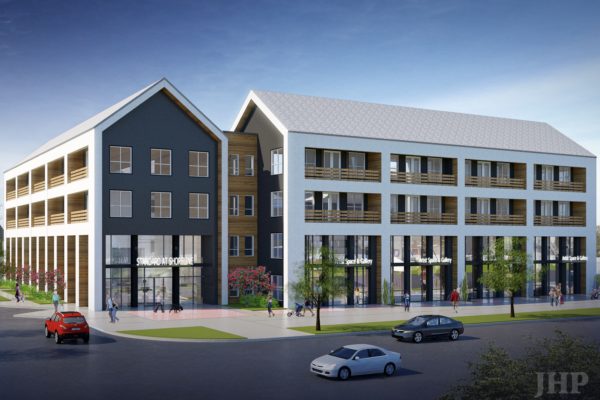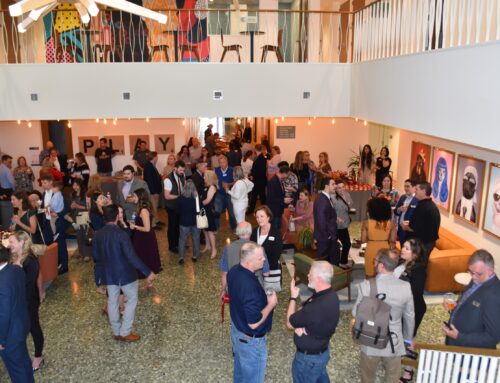
Standard Shoreline. Rendering courtesy of Ojala Holdings.
Standard Shoreline, the mixed-use project proposed for the Shoreline church site at Garland Road and Centerville, received unanimous approval from the Plan Commission.
The development plan calls for 282 multifamily units in four stories wrapped around a parking garage. There will be 18 townhomes, 3,000 square feet of creative office space and an art park fronting Garland Road.
Nine months after Ojala’s initial planned development submittal to the City of Dallas, all Plan Commission members present supported District 9 Commissioner Michael Jung’s motion to approve at the Sept. 15 meeting.
Four members of the Ojala team and 14 others spoke in favor of Standard Shoreline, most of them in one way or another citing a lack of affordable housing in Dallas as the compelling reason to approve the project. Speakers supporting the project included Mike Nurre of Greater Casa View Alliance, D’Andrala Alexander, founder of More Neighbors Dallas, and Leslie Whitmore, owner of a Montessori preschool on Garland Road.
Fifteen speakers opposed the project. After nine months of meetings and social media, there were no surprises. No speakers objected to the affordable-housing component, although a few tossed barbs at the tax treatment Standard Shoreline will receive under the new Dallas Public Facility Corporation program. Traffic, storm-water run-off and potential school overcrowding were raised, but building height and density remained the primary objections from the Lochwood residents in attendance.
Scott Robson, president of Lochwood Neighborhood Association, wanted to see less “mitigation” of the building height through fences and trees and more “elimination” of the fourth floor. Bruce Parrot, a Yorkmont Circle homeowner, and Neil Felder, owner of Eastlake Medical Office, have properties that sit directly south of the project; both spoke in opposition. Parrot did not like the idea of his home near a four-story structure, and Felder foresaw traffic problems affecting his medical tenants.
Thomas Buck, communications director for the Lochwood Neighborhood Association, said 2,000 people had signed an online petition opposing the project, and 150 more had mailed their signatures.
Plan Commission members inquired about guest parking, an oral tour of the property by Ojala describing ingress and egress, and establishing certainty that the project met the residential proximity slope requirements. The residential proximity slope requirement in the development code is meant to protect residential areas from adjacent tall buildings.
Plan Commission protocol is the commissioner where the subject site is located makes the initial motion. Commissioner Jung motioned for approval, subject to staff’s recommendations and two minor amendments to the planned development and site plan.
“This is the end of a long road that began for me in January, and I’m ready for it to be over,” Jung said. “The original plan for this project has changed radically based on the comments, desires and suggestions of the public, the staff, the Garland Road Vision Task Force and several members of this commission. The project is a much better project because of that participation.
“The project will provide much-needed housing, will serve as a catalyst for improvement to this part of Garland Road, which is sorely in need of investment and renewal,” Jung said. “It will make a small but important move toward greater pedestrian orientation in this corridor in the form of the art park and the creative office.”
Jung stressed that the opposition to the tax benefits Ojala is receiving is not a land-use consideration, and “concerns about that aspect of the project should be directed elsewhere.”
“To turn down that proposed use because of what might potentially someday otherwise might go there is to invoke the principle that the perfect is the enemy of the good,” Jung said.
He addressed the height issue, citing that he had asked the developer to approach the church about a reduction in land sale price to make three stories economically viable. Jung said the applicant did that but was unsuccessful.
“So the question is not four stories versus three stories,” Jung said. “The question is four stories versus denial.”
“We have an extraordinary package of height intrusion protections, far greater than we normally see in a typical case and sufficient in my view to adequately protect Yorkmont Circle from the height intrusion of the project.”
District 14 Plan Commissioner Melissa Kingston was the only other commissioner to speak and supported Jung’s motion “enthusiastically.” She provided some reassurance to the opposition from her personal experience with an eight-story project near her single-family community and that “it really isn’t as bad as it may seem today.”
Kingston also said that communication to her office from supporters was “significantly more” than communication from the opposition.
Buck said those opposed to the rezone were not shocked by the commission vote.
“But, their assessment was from a certain, narrow perspective, and much narrower than the gaps between the proposed townhomes, revealing the sight lines that will appear into our neighbors’ properties from a fourth-floor viewpoint,” he said. “Commissioner Jung mentioned our aim to be perfect is ‘the enemy of good.’ We are not looking for perfection, but simply better. We do not want to settle for ‘good.’ ‘Good’ to the Commission does not seem to include finding a more compatible, appropriate and suitable solution when developing next to a neighborhood.
Lochwood neighbor Jessica Mannon said the commission should have decided on the best, not the easiest, land use.
“We feel this process fell short of the rigorous examination we would expect from our commission,” Mannon said.
Daniel Smith and Matthew Vruggink, who have navigated this course for Ojala, declined to comment, presumably letting the unanimous vote for approval speak for itself.
The final step for approval will be another public hearing and vote, this time at Dallas City Council. No schedule has been set, but it could appear on the agenda in mid-to-late October.





